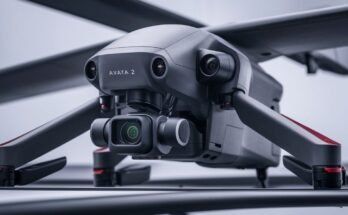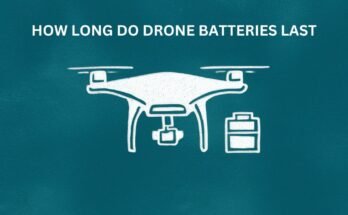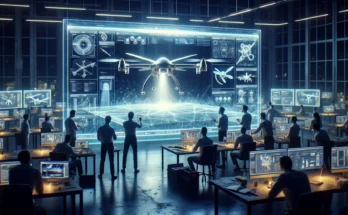Introduction:
Do All Drones Have a Camera?
In the vast expanse of the sky, drones have become synonymous with exploration and innovation. Yet, a fundamental question lingers: do all drones come equipped with a camera? As technology propels us further into the future, the presence or absence of this pivotal feature defines the drone landscape.
Join us on a succinct journey through the realms of camera-equipped drones, non-camera counterparts, and the evolving technologies that shape our airborne companions. Let’s unveil the mysteries of these skyward explorers together.
Distinguishing Features
Drones come in all shapes and sizes, tailored to suit different needs and applications. Knowing the main characteristics that make them different is a prerequisite for anyone entering into unsettled air.
Camera-equipped Drones:
Camera-equipped drones, beloved by aerial photography and videography fanatics, put the world on new heights. Well, in more ways than one. Literally speaking too! Equipped with high-resolution cameras, these drones capture images and videos from amazing vantage points never before attainable.
Today’s strapping aerial photographer is no longer restricted to the hobbyist chasing after pretty landscapes, nor relegated strictly to serious professionals making cinematic masterpieces.
Non-camera Drones:
However, non-camera drones also have uses besides taking pictures. These drones are intended for work like surveying, mapping and delivery services. Designers remove the weight and complexity of a camera.
Flight time increases; efficiency too. Non-camera drones are used in industries where data collection and quick, accurate positioning play more important roles than photography.
When one understands the basic difference between these two types of drones, navigating the market becomes easier. It’s also an important decision to make for aerial photographers looking their best shot or industry professionals working on efficiency.
Which you choose determines what kind of drone flying experience lies in store for you. Read on as we delve into the technical details in sections to come.
Exploring Camera Technology
In the realm of drones, the camera is not merely an accessory but a defining element that shapes their capabilities and applications. Let’s dissect the nuances of consumer and professional drone camera technologies.
Consumer Drone Camera Technology:
Consumer drones have democratized aerial photography, making it accessible to enthusiasts and hobbyists. These drones typically feature built-in cameras with varying resolutions and capabilities.
From budget-friendly options offering basic photo and video functions to advanced models boasting stabilized gimbals and intelligent shooting modes, consumer drone cameras cater to a broad spectrum of users.
The technology powering these cameras continues to evolve, with advancements in image sensors, lenses, and stabilization systems. Drones equipped with obstacle avoidance sensors and automated flight modes enhance the user experience, allowing even beginners to capture professional-looking shots effortlessly.
Professional Drone Camera Technology:

For professionals in fields such as cinematography, surveying, and mapping, drone cameras are sophisticated tools with advanced capabilities. Professional-grade drones often incorporate high-end cameras with larger sensors, enabling them to capture detailed images and videos in various lighting conditions.
These drones may feature interchangeable lenses, providing flexibility in capturing different perspectives. Additionally, advanced gimbal systems contribute to stable footage, crucial for achieving cinematic quality. Pro-level drones are designed for precision and reliability, equipped with intelligent flight modes and redundant safety features to ensure optimal performance in demanding scenarios.
Knowing the subtleties of consumer and professional drone camera technologies lets users select according to their individual needs. In the following sections we will look at market trends, military applications and changing drone technologies. Check back for a glimpse into the many different aspects of camera-equipped drones.
Market Insights
To appreciate the scenery of drones and their camera merits, what you have to do is explore today’s market trends in these unmanned aerial vehicles (UAVs) as well as the assorted tasks they perform.
The Current Drone Market:
Drone technology, which is both advancing and proliferating rapidly in use experience explosion. Consumer drones have gone mainstream, with photography buffs and content creators both drawn to them as well. From entry-level drones It has a basic camera function to high-end models with advanced features, the market is flooded.
On the career side, Drone technology is increasingly becoming part of diverse industries such as agriculture, construction and surveillance. Thanks to the versatility of drone applications and breakthroughs in camera technology, several specialized drones adapted for various industries have been released.
Consumer Drone Market Trends:
Portability, ease of use and improved camera capabilities are key trends in the consumer drone market. Drones with advanced cameras that are foldable and compact, ideal for users who place a priority on convenience but don’t want to compromise image quality. Smart flight modes, automatic editing function and extended battery life are the major trends dominating consumer drone market.
Military Drone Capabilities:
While consumer and professional drones rule the roost among civilian customers, military drones are an increasingly important instrument for defense and surveillance. Many of these drones carry state-of-the art camera systems and other sensor technologies that allow them to deliver real time intelligence, surveillance, reconnaissance (ISR) capabilities. Drones used in the military come in all shapes and sizes, from small drones for reconnaissance to heavy armed UAVs.
To gain insight into the development and future direction of technology it is important to understand the trends, in the drone market. In this exploration we will delve into the capabilities and potential uses of drones equipped with cameras. From timeless favorites to groundbreaking innovations, in exploration join us on a journey through the diverse realms of drone technology.
Functionalities and Uses
And besides their technical characteristics, the real value of drones with cameras is in apparatus and applications. They help filmmakers to record earth-shaking aerial views; they play irreplaceable roles in industry after industrial and can even save lives. It’s clear that the arrival of unmanned vehicles is going to have an enormous impact on our outlook, thought, customs and habits.
Camera Technology in Drones:
Development of camera technology for drones has been an important factor in their increased use. Modern drones have cameras that can do a lot more than just take pictures. High-def. sensors, stabilized gimbals and smart technology let you take professional photos and videos. Understanding the mysteries of camera technology, however, is the only key that can unlock their full potential.
Uses for Drones with Cameras:
Aerial Photography:
With consumer drones equipped with cameras having made aerial photography available to everyone, from amateurs to professionals, we can all get stunning perspectives.
Cinematography:
Drones are certainly a helpful tool for filmmakers–a powerful new one in the hands of professional pilots, allowing them to invent dramatic angles and sensational aerial shots.
Surveying and Mapping:
In surveying and mapping applications for construction, agriculture, etc., high-resolution camera equipped drones are used to gain detailed yet current data.
Search and Rescue:
Drones equipped with thermal camera are ideal tools for search and rescue. They can ask about missing people, or assess damage in disaster areas.
Environmental Monitoring: Drones monitor wildlife, assess vegetation health and conduct research in areas too remote or off limits to normal approaches.
Vintage Drones with Cameras:
The history of drones with cameras goes back to crude prototypes from earlier days. Yet early, crude drones of the antique era opened up a whole new area in unmanned aviation–the use of cameras.
Looking back upon the development of drone technology puts recent breakthroughs in perspective.
The Future of Drones and Cameras:
As technology keeps advancing, the days to come for camera-equipped drones look more promising than ever. Advances expected include greater autonomy, better obstacle avoidance systems and the incorporation of artificial intelligence to make flight more intelligent and adaptable, as well as imaging more effective.
Drones and emerging technologies have intersected, opening up a future in which drones will be even more flexible.
To truly appreciate the impact drones with cameras have over so many different sectors, it is necessary to understand their functionalities and applications. In the following sections, we will examine some of these ethical problems concerning drones and surveillance in detail.
So stay tuned for a balanced look at the advantages and pain points of drones with built-in cameras.
Ethical Considerations
Drones equipped with cameras have quickly entered our lives and many different industries, creating a host of ethical problems surrounding privacy rights, the role of surveillance technology and its potential misuse. In the air with these wonders of technology, we cannot ignore examining their ethical ramifications.
Balancing Innovation and Privacy:
But the emergence of drones with cameras has started discussions on how to balance technological development and individual privacy. However, when drones take photos or video out in public spaces this effectively interferes with the private lives of individuals.
Finding the right balance between promoting innovation and protecting personal privacy is a knotty problem that policy makers, technology developers–and indeed all of us as members of information society-need to confront.
Surveillance Drones and Civil Liberties:
Whether government agencies or private individuals, the use of drones for surveillance also triggers problems that threaten civil liberties–the uninvited intrusion into people’s lives. Clear cut regulations and ethical guidelines must be in place to guarantee that the use of surveillance drones falls within legal channels, does not violate people ‘rights to privacy or freedom from Go
Responsible Use in Sensitive Areas:
Some environments, like controlled airspace or highly sensitive infrastructures and government services, compel higher concern concerning the safe operation of drones. Drone flights in sensitive areas are strictly regulated by special laws and geofencing technologies to prevent unauthorized over-flights, thereby reducing dangers to national security that may be caused either through intentional misuse or accidental mishaps.
Data Security and Consent:
When it comes to images and videos captured by drones, there are concerns for data security and informed consent. Users and operators have to follow data protection regulations, so that drone-captured information conforms with privacy laws. In particular, he emphasizes the importance of developing strong cyber security to prevent unauthorized access and misuse of confidential information.
Public Perception and Acceptance:
Public perception and understanding of drones with cameras will determine their common use. The use of drones is transparent, educational activities help readers build trust and dispels fears. Interaction with the public to air concerns and provide information on responsible use of drones promotes technology X society.
Drones with cameras are like walking a tightrope in this regard, they demand that we strike the proper balance between technology and fundamental rights.
This exploration is intended to end with the last section giving useful advice on how best to buy and use drone cameras. For important advice and tricks to help you in the aerial world, stay with us.
Practical Guidance
Armed with such a knowledge of the differences among drone types, how camera technology works, market trends and multiple applications, even some ethical considerations, it’s time to offer up something practical for those entering this world.
How to Buy a Drone Camera:
There are several things to consider when you’re buying a drone with built-in camera.
Purpose: Know your purpose- Is it grabbing that right angle, videoing an accident in progress or getting a clear shot of the center field from the edge of the stands?
Camera Specifications: Camera resolution, sensor size and features such as image stabilization should be evaluated to achieve the best results.
Flight Time and Range: Take into account the flight time and range of the drone to make sure it meets your needs.
Ease of Use: If you’re a beginner, select one that fits your level; if experienced, find another.
Regulatory Compliance: Ensure you understand, and abide by local regulations on drone use.
Do All Drones Have a Camera:
Choosing the Right Model: Choose a drone that fits your skill level, budget and needs.
Maintenance: Inspect and maintain your drone frequently so that it will perform well for a long time.
Flight Safety: Obeying safety guidelines, such as no-fly areas and responsible flying.
Drones without Cameras:
Specialized Functions: If, instead, your interests are tasks like surveying or mapping, select drones tailored to these areas.
Payload Capacity: Check paying capacity if you plan to add third-party cameras or sensors.
How to Use a Drone Camera:
Practice Flight Skills: Practice your flying skills in the open before trying difficult maneuvers.
Understand Camera Settings: get to know camera settings.
Respect Privacy: When taking pictures or making video in public spaces, adhere to ethical guidelines and legal privacy regulations.
Responsible Aerial Photography:
Respect Privacy: Do not take photos of people without consent, especially in private places.
Follow Regulations: Observe local regulations and standards governing drone flights and photography.
Droning on but with opportunities comes responsibility. If you make informed choices, understand the technology and are mindful of ethical considerations, not only will your hobby lead to a happier you but help this thriving community stay positive.
Fly safely and capture the world from new perspectives.
Conclusion
Taking us on a sweeping journey through the booming world of unmanned aerial vehicles, in the sky where invention meets technology, here is whether or not all drones have cameras.
We’ve pulled the thread on everything from knowing the differences between a camera drone and one without to peeling back the intricate consumer-versus-professional OEM world of digital cameras, starting with understanding what defines a real live flying image taking off.
Looking at the various trends in markets, applications and ethics has given us a comprehensive understanding of both the obstacles as well as possibilities that lie ahead for this changing technology.
In this regard, as we deliver concrete suggestions for purchasing and operating drone cameras in a responsible manner, we hope that amateur fans alike can experience the exciting world of air exploration with wisdom.
Within a sky less world, let responsible innovation and ethics play a role. A new horizon of drones equipped with cameras can bring something positive into our lives.





One Comment on “Do All Drones Have a Camera | Ultimate Explorers of the Sky”